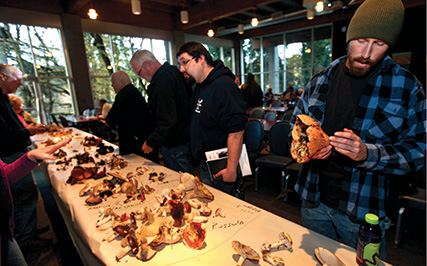Health & Education
Seminar sprouts interest in mushrooming

There is something growing on the Tribal Reservation besides timber that might have value to Tribal members - mushrooms.
Almost a full house at the Elders Activity Center on Tuesday, Nov. 10, listened to Bureau of Land Management Botanist Ron Exeter discuss mushrooms.
Tribal Elder Harold Lyon, a member of the Tribe's Fish and Wildlife Committee and organizer of the presentation, along with community member Bob Duncan picked the majority of some 50 varieties on display during the event. Lyon said the mushrooms are growing all over the Reservation.
"The committee has been wanting to do this for years," said Lyon. "This year I said I'm going to do it." He contacted Exeter to give the presentation and the idea sprouted to life.
Lyon said he has been hunting mushrooms for 25 to 30 years and today he distinguishes edible from the merely distasteful and poisonous through his own experience. And, after all these years, he says, he still uses a reference book.
Al Miller, a member of the Veterans Special Event Board and also a past-president of the Salem Mushroom Society, also attended.
Not everybody responds the same, even to edible mushrooms. "Line up 100 people," said Exeter, "and some report an upset stomach while others find them good to eat. Take a small bite the first time you eat them," he advised, "and see how you do."
Although most of the more than 14,000 varieties of mushrooms are edible, they are not easy to distinguish.
"Some of these are edible," Exeter said, referring to a whole family of mushrooms.
Distinctions he made came in the form of differences among caps and gills, stipes (or stems), colors and spores.
Tribal Elder Leonette Galligher said the technical terms went right by her, but she enjoyed the overall presentation.
"It was interesting," she said.
"Tons of people in the U.S. eat them," said Exeter, adding that people do die from eating mushrooms. Over the past 35 years, an average of two to three people per year die of mushroom poisoning in the United States, according to the North American Mycological Association.
It is no wonder with the range of mushrooms out there. Along a few tables that stretched across the front of the lunch room, mushrooms were everywhere. They were grouped according to family, and some were edible, others were not.
Colors ranged from yellow and orange to black and white. Some of them change color when they are touched. Squirrels eat some that people also consume and some that are poisonous to humans. Groups of them grow together, and some are parasites growing on hardwood trees, others on spongy, decaying wood.
Mushroom names included Chicken of the Woods, Slippery Jacks, Poison Pax, Tube (also called Boletes), Club, Coral and Tooth fungi. Puff Balls, Cauliflower and Jelly fungi are edible, but Cauliflower get wormy and Puff Balls resemble a poisonous variety. The only way to tell is to cut them in half, Exeter said.
There are slime molds that also are called Deer Puke. "They have patches of yellow, and I guess they look like deer puke," said Exeter. Some have the odor of fish or shrimp; some ooze a substance called "latex" when cut, though not the kind of latex found in paint. Red or orange latex mushrooms are edible, but other latex mushrooms may be inedible.
Asked whether he is now ready to hunt mushrooms himself, Tribal Elder Duane Wheeler deferred. "No. I think I'll buy mine at the grocery store," he said.
Galligher said she remembered that Pike Place Market near the wharf in Seattle has "tons of mushrooms," all in neat little sections. "I know they're good," she said, "because they picked them out."
Senior Services Cook Kevin Campbell said he has cooked regular button mushrooms for many Elders' lunches, but has neither hunted nor cooked the more exotic varieties at work. Asked if, following the presentation, he would cook these other varieties, he said, "Any time. If they want to pick them and bring them in, I'll make them."
At home, he said, he sautés lobster and chanterelle mushrooms with peppers and other vegetables. They go on spaghetti or over hamburgers, he said.
Donn Grishaber said he has hunted mushrooms a couple of times, bringing a book along. "They're real interesting to me. They're better after a rain."
"I didn't realize there were so many so nearby," said Galligher.
Tribal members can obtain a free 30-day gathering permit from the Natural Resources Department to gather mushrooms on the Reservation. However, if they plan on selling the mushrooms, they must pay a $5 fee.
The event was sponsored by Tribal Council, the Fish and Wildlife Committee, and the Education and Land and Culture departments. In addition to the presentation, there were door prizes and dessert.
